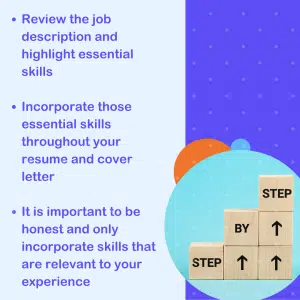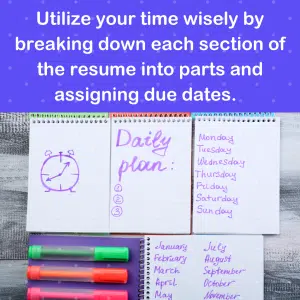This article will define what tailoring a resume and cover letter means, why tailoring is essential to be considered a top candidate by employers, and some strategies on how to get started tailoring these documents.
What is a Tailored Resume and Cover Letter
To be considered a top applicant, it is important to tailor your resume and cover letter for each job you apply for. Tailoring these documents means that you are showcasing your relevant skills and qualifications by incorporating keywords related to the skills, experience, and other position requirements.
Most keywords that an organization’s Applicant Tracking System (ATS) database and hiring managers look for are found within the job description, especially the skills and responsibilities sections. By tailoring your resume and cover letter with keywords, you can significantly improve your application’s chances of making it through an ATS and capturing the hiring manager’s attention.
Read our previous article, Understanding Keywords and Applicant Tracking Systems, for a more in-depth review of keywords and ATS.
There are many benefits in tailoring your resume, including but not limited to:
- It significantly increases your chances of receiving an interview.
- It helps you stand out from the crowd.
- It demonstrates how you are the best fit for the job.
- It shows evidence of prior research into the organization and a comprehensive understanding of the job requirements.
- It shows that you are willing to go above and beyond and put in extra effort to secure a job.
While reviewing each job listing for keywords and determining if they align with your experience can be time-consuming, completing this step for each application is critical because the words employers search for will vary from job to job. In the next section, we have shared some tips to help you navigate this essential step in your job search.
Research has backed up the importance of having a tailored resume and cover letter.
- 83% of recruiters say they’re more likely to hire a candidate who has tailored their resume to the specific job they’re applying for.
- 63% of recruiters like to get resumes personalized to the job position.
- 55% of recruiters say that the biggest mistake job seekers make on their resumes is not tailoring their resume to the specific job they are applying for.
How to Tailor a Resume and Cover Letter
The first step is to understand the job you are applying for. Go through the job description and highlight points mentioned repeatedly and skills that seem essential to that position. By doing this, you are identifying keywords! This is essential because without knowing what the job entails, you will not know how to show the employer that you have the skills they are looking for.
After reviewing the job description, you should have a good understanding of what the hiring manager is looking for.
The next step is to review your resume and decide where you can highlight these skills best, such as the summary section, experience section, and skills section.
For example, you might see the keyword social media mentioned several times throughout a job description. In this case, you will want to ensure that you add in any relevant social media experience that you have to your resume and cover letter; ideally using similar terminology that is used in the job description.
To learn about the different sections of a resume, download our Guide to Resume Writing.
Consider getting a second opinion. Ask a friend or a mentor to review your resume and compare it to the job description it was tailored to. See if they get a good understanding of why you would apply and how your background is a good fit for the role. This additional feedback can help you identify missing keywords you may not have otherwise thought of.
Now that you have a tailored resume, you can follow a similar pattern for your cover letter. Although not all jobs will require a cover letter, if required, you should always tailor it to the job you are applying for. A cover letter functions to complement the resume by tying together your experiences with your interest in the position and company.
To help tailor and optimize these documents quicker, you can use AI-powered systems such as Jobscan. Jobscan works by scanning your resume just like an ATS database would and highlights those hard skills and soft skills for your consideration. It can also provide suggestions for how to incorporate these keywords directly in your documents.
How to Make it More Manageable
Updating and tailoring a resume can feel overwhelming, exhausting, and time-consuming. It may cause stress just thinking about it. Remember, slow and steady wins the race. Utilize your time wisely before an applications deadline by breaking down each section of the resume into parts and assigning due dates.
For example, write one section each day of the week. Monday you can edit or revise your executive summary. Tuesday, you can revise and tailor your employment experiences to relate to the job you are applying for. Wednesday, perhaps you can revise your skills to better suit the role you are applying to. Thursday, add in your relevant strengths. Friday, add in your achievements and references.
When creating your schedule, give yourself 1-2 days before the application is due to focus on review. This will give you time to read through the document with fresh eyes and finalize it before you submit your documents.
Some additional tips to consider:
- Keep a base resume. This is a resume with all your previous work-related skills and experiences that you can use as a reference document. This can help you pick and choose your relevant experiences for a tailored resume quickly.
- If you are interested in multiple industries, create a few versions of your resume pre-tailored to different roles.
- Do not spend time applying to jobs with duties that you are not interested in or requirements that do not align with your experience. Being selective of which jobs you apply for can help reduce the amount of time you will spend on tailoring your documents.
Advice submitted by OAR’s Community Support Coordinator
“When I was applying to become a Learning Coach at George Mason’s autism program, I enlisted the help of a Hire Autism Navigator. Together we reviewed the job description of the position and identified key skills and responsibilities such as helping autistic students achieve academic success, organization, problem-solving and more.
With the help of my Navigator’s suggestions, I was able to tailor my resume to the job by removing irrelevant experience such as the ability to speak Hebrew, public speaking skills, and a previous pizza delivery job and replace them with more related experience such as the skills I obtained in a student support coordinator role.”
Additional resources





